Shimano GE900HS Shoes
Test Locations: Washington, British Columbia
Test Duration: 5 months
Reviewer: 6’, 160 lb / 183 cm, 72.6 kg
Size Tested: EU 44
Blister’s Measured Weight (per shoe, EU 44): 432 and 438 g
Upper: Synthetic leather
Closure: BOA + velcro strap
Pedals Used: Shimano XTR Trail, HT X2, HT X3, HT T2
MSRP: $275
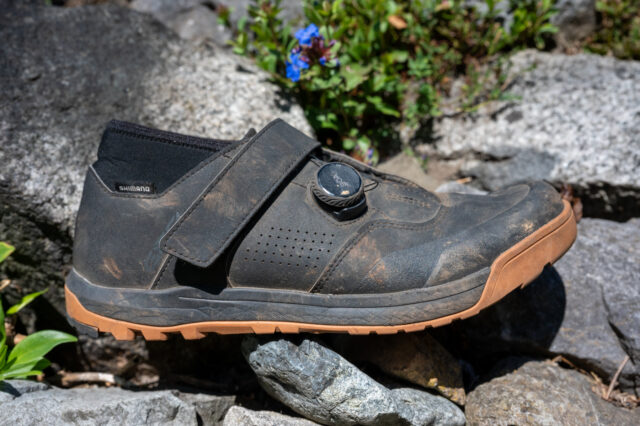
Intro
Shimano took a bold step when they replaced both their longstanding ME7 and AM9 Trail and Gravity clip shoes with a single model, the GE9, a couple of years ago. Personally, I was happy with the update — the GE9 worked better for me than either of the models it replaced — but it wasn’t a direct one-to-one match for either, and some folks (especially ME7 fans) felt left out in the cold.
Now there’s a new addition to the lineup. The GE9HS (the “HS” stands for “Hot Seat,” a nod to their gravity race focus) looks almost identical to the standard GE9 (which sticks around as well), but it’s slimmed down, a little lighter, and features a stiffer sole — all of which make it more like the ME7, at least on paper.

[Shimano also launched a couple of other new gravity shoes at the same time, including a women’s version of the GE9, a new GF8 flat pedal shoe in both men’s and women’s versions, and a waterproof GE9GTX, which looks a bit like a clip version of the excellent GF8GTX flat pedal shoe.]
I’m super excited about that last one, and will be testing a pair when the weather turns this fall, but in the meantime, let’s turn our attention to the new, allegedly more race-focused version of the already very good GE9. How does the GE9HS compare to both the standard GE9 and Shimano’s earlier offerings? Here’s my take:
Features and Construction
First, a quick point of clarification regarding Shimano’s naming convention: the current GE9 / GE9HS are the first iterations of the GE9 lineage, so they’re dubbed the GE900 / GE900HS; in theory, future versions will be named GE901, GE902, etc. I’ll mostly refer to the GE9 / GE9HS / ME7 / AM9 throughout for simplicity, but will differentiate where needed.
In terms of features and appearance, the GE9HS is, at first glance, pretty much identical to the GE9, apart from colors. Their silhouettes are extremely similar; both use a BOA dial as the primary closure with a velcro strap over the instep; both feature a short neoprene ankle gaiter; and they use the same outsole.
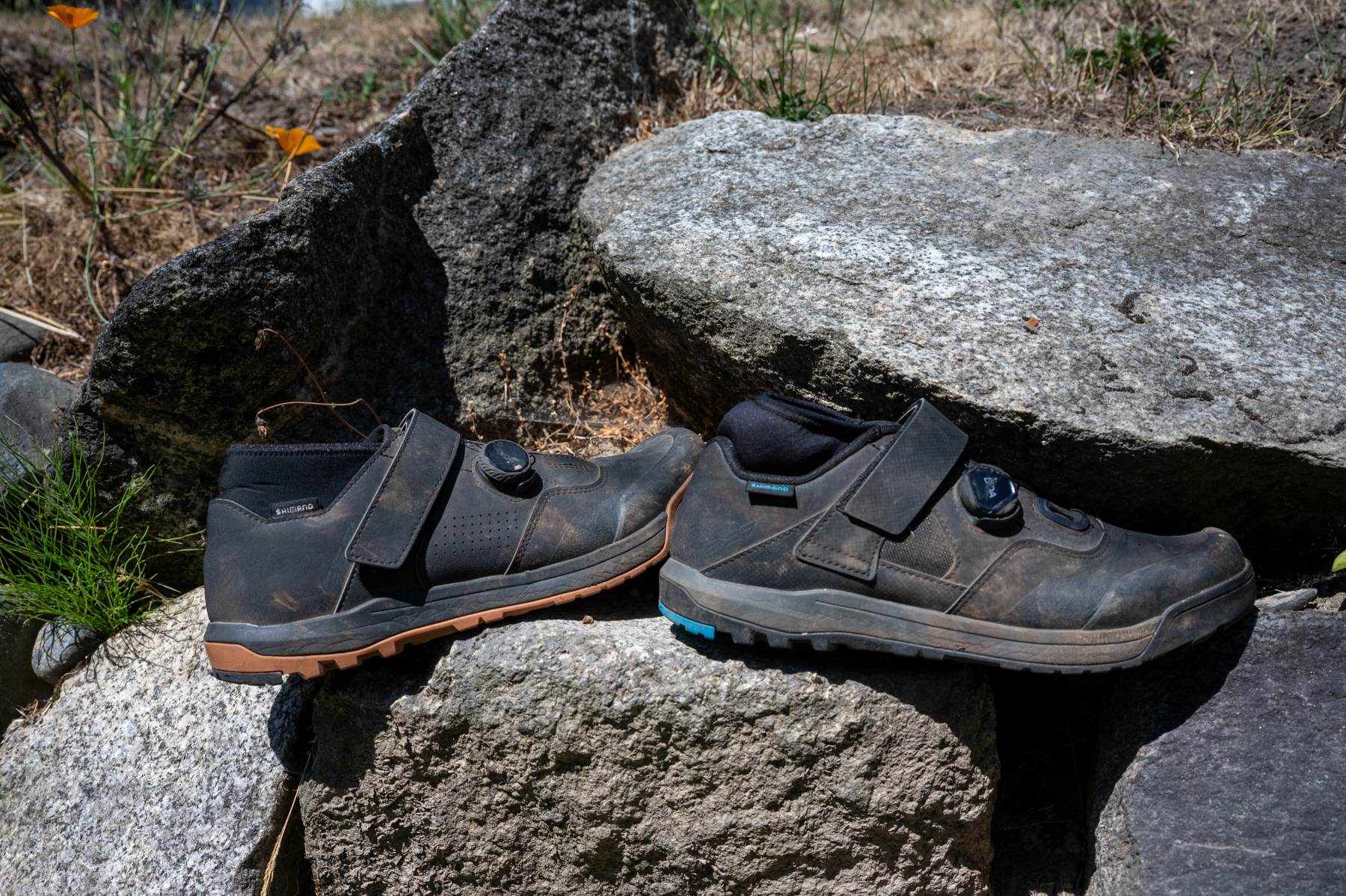
The main differences are that the GE9HS gets a slightly stiffer midsole (Shimano rates it an “8” vs. a “7” for the standard GE9), a little less padding throughout (most notably in the heel pocket and tongue, though also in the mid- and forefoot), and a slightly lower-volume fit, especially in the forefoot. The two also use different versions of a BOA dial (though I don’t find it to make much difference in practice), and there are some subtle differences in the patterning of the upper. So, all told, not big differences on paper.
I’ll just quote from my review of the GE9 (lightly edited for clarity) for this next bit, since it fully applies to the GE9HS, too:
The BOA dials that Shimano uses for the main closure on the GE9 feature plastic guards that surround the forward part of the dial to help it brush off impacts and, Shimano says, avoid accidental loosening when getting smashed on stuff. When I first started wearing the GE9s, I found myself initially trying to grab the portion of the dial that was covered by the guard when I went to adjust the dial, but I pretty quickly re-learned where to grab the dial and haven’t thought about it since. A velcro strap over the instep provides some welcome extra adjustability and helps hold the heel back in its cup. Some folks will undoubtedly miss the ratcheting buckle used on the ME7 in place of the velcro strap, but I personally find the latter to be easier to adjust accurately (though the velcro itself will undoubtedly have a finite lifespan).
One of the defining features of the ME7 was the neoprene ankle gaiter, intended to help keep dirt and other gunk out of the shoe, and the GE9 gets a version of that as well. It’s not meant to be waterproof, but rather offer some protection from dirt, pebbles, and so on; while it’s not 100% perfect in doing so, I’ve found it to work pretty well. Sealing off the ankle area probably hampers breathability a little bit, but the GE9 is still respectable on that front — notably better than the AM9 or Specialized 2FO DH, for example.
The cleat slot on the GE9 is moderately long and fairly average in terms of placement, relative to most modern gravity-oriented shoes. The Endura MT500 Burner or many of Ride Concepts’ offerings are still the best options I’ve tried to date for folks who want to run their cleats super far back on the shoes, but I’ve been able to find a position that I like on the GE9s with a little wiggle room to play with (for reference, I can rarely get cleats as far back as I’d like on many more XC-oriented shoes).
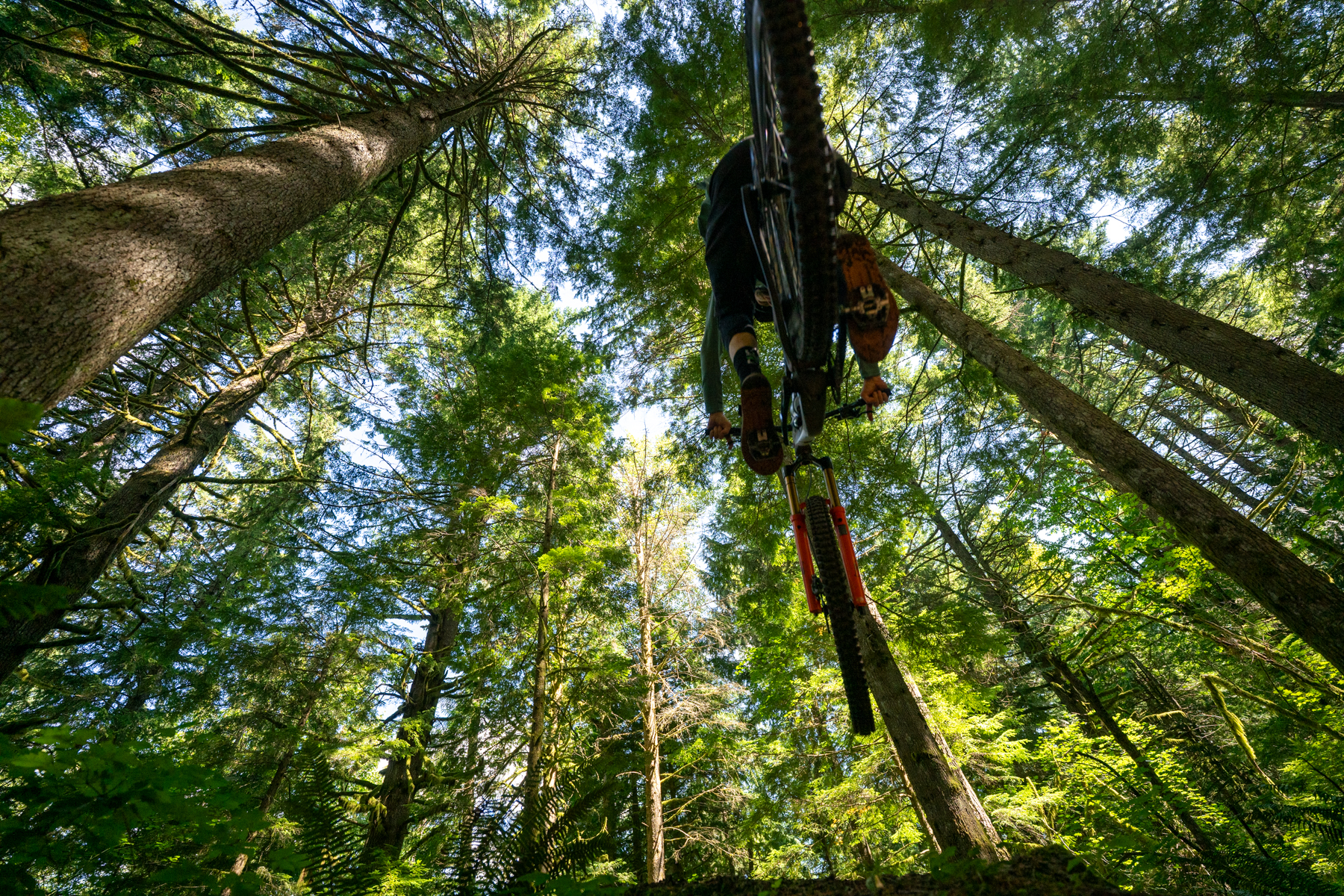
There are also a few other, mostly minor tweaks to the GE9HS vs. the standard GE9. The loops that the BOA laces wind through are hidden under the sides of the upper, rather than being on top, where they’re a little more liable to get caught on stuff; the GE9HS does away with an extra panel on the inner face of the upper in the name of slimming things down a touch; and the GE9HS also does away with a small panel of more breathable ripstop material on the outer face of the upper, instead featuring some extra perforations in the synthetic leather panel there.
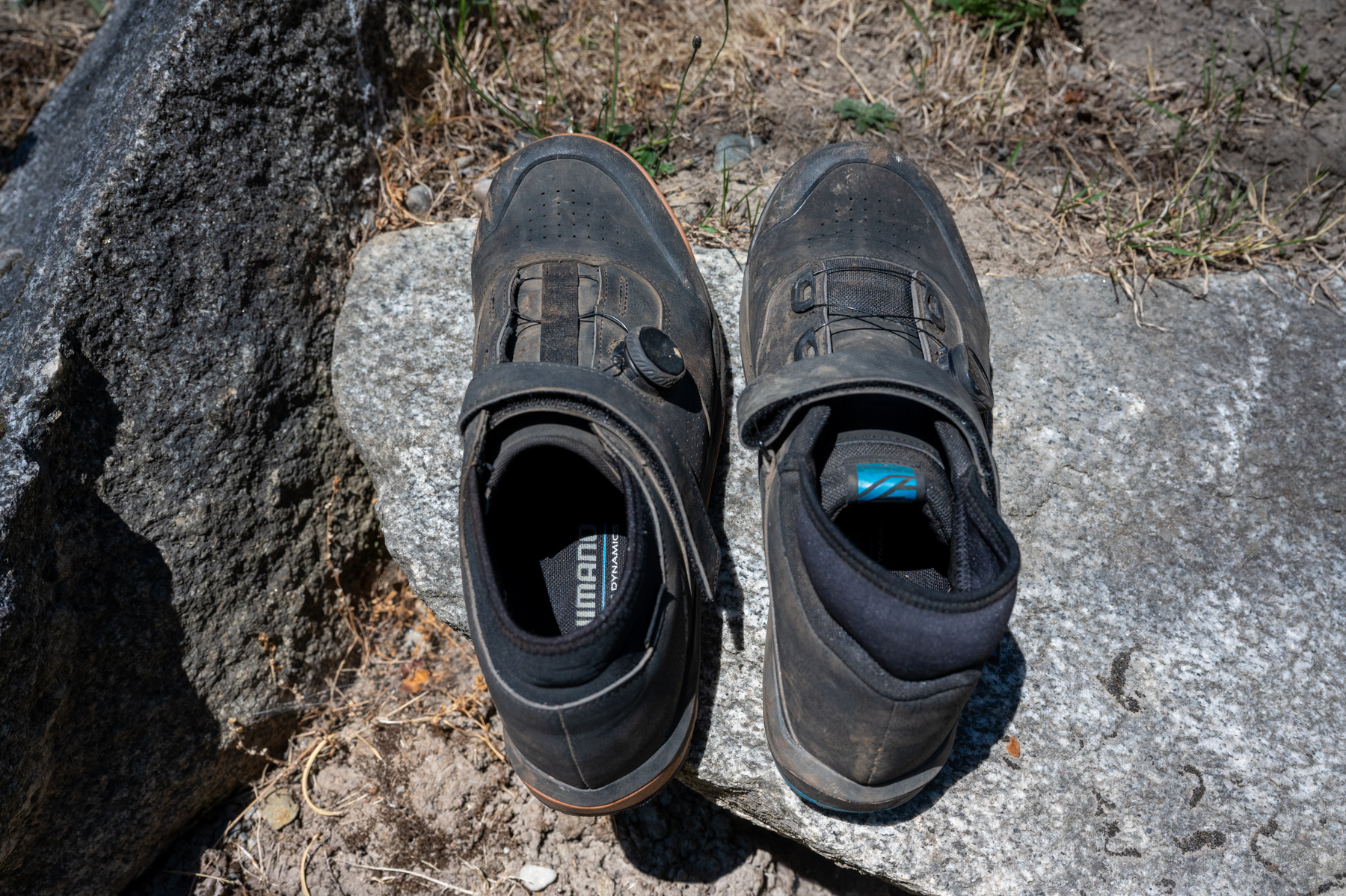
Fit
The fit of the GE9HS is very similar to that of the GE9. Check out our review of the GE9 for a more in-depth rundown of that shoe; here, I’ll focus on the GE9HS and how it compares to the GE9.
[For reference, I wear a US 10 street shoe and have consistently worn an EU 44 in Shimano’s shoes, the GE9HS included, which tend to run a little smaller in EU terms than a lot of other brands. I’m often an EU 43 or 43.5 elsewhere. Shimano’s size chart calls the 44 a US 10, which I’d agree with.]
Overall, I’d rate the GE9 HS as being pretty middle of the road, volume-wise, for a gravity-oriented shoe. It’s a little more snug than the GE9 in the forefoot / toe box, but not by a ton; the toe box of the GE9HS feels a little more tapered (i.e., gets shorter length-wise as you move to the outside of the foot), but that difference is fairly subtle, too.
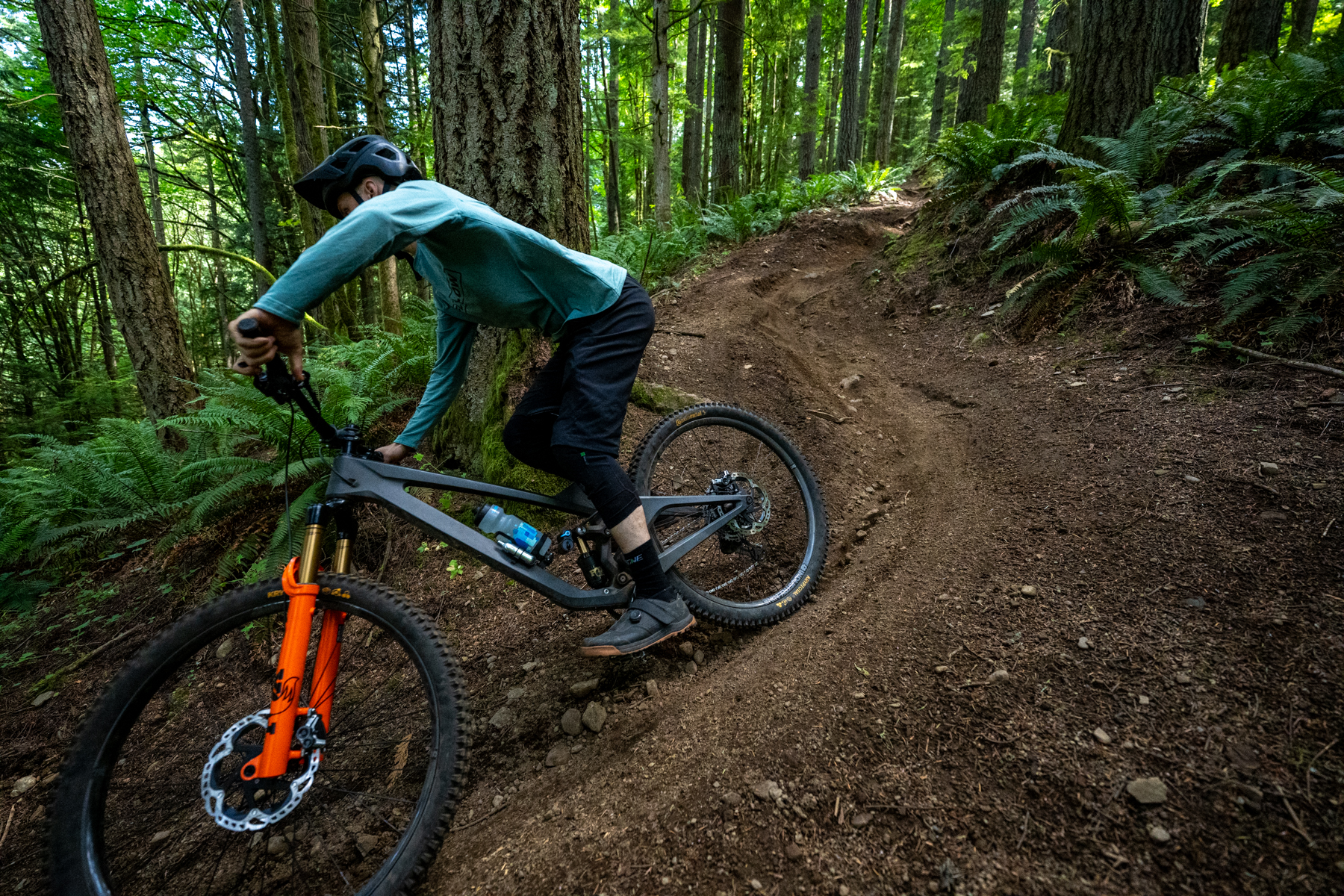
That said, the two feel noticeably different, but I think it’s got as much to do with their construction as the actual fit. The GE9 is more padded and cushier, while the firmer, less padded GE9HS feels more snug and secure in how it holds your foot — but a lot of that has to do with the upper of the GE9 just feeling cushier, rather than the last being all that different.
All that makes the GE9HS feel a little more like the departed ME7 than the standard GE9 is, but not by that much. The ME7 (specifically the most recent ME702 generation version) is still a lower-volume shoe with more XC influence in its design, including a stiffer and more rockered sole.
On the Bike
The standard GE9 has been one of my favorite options for a gravity clip shoe for a while now. It fits my feet (which are relatively wide in the forefoot but taper to a narrower heel) reasonably well, strikes a nice balance between being reasonably protective without feeling like the ultra-bulky skate-shoe-inspired options of old, and features a sole that’s a nice middle-of-the-road stiffness for my taste.
The following things about how the GE9HS compares to the GE9 are all true:
(1) They’re more similar than they are different, and I think most folks who like one will also get along with the other.
(2) Choosing between the two mostly comes down to whether you want a slightly stiffer, less cushy option that provides a more direct-feeling connection to the bike (GE9HS), or a softer, potentially slightly more comfortable version (GE9).
(3) I like both a lot, and clearly, albeit narrowly, prefer the GE9HS.
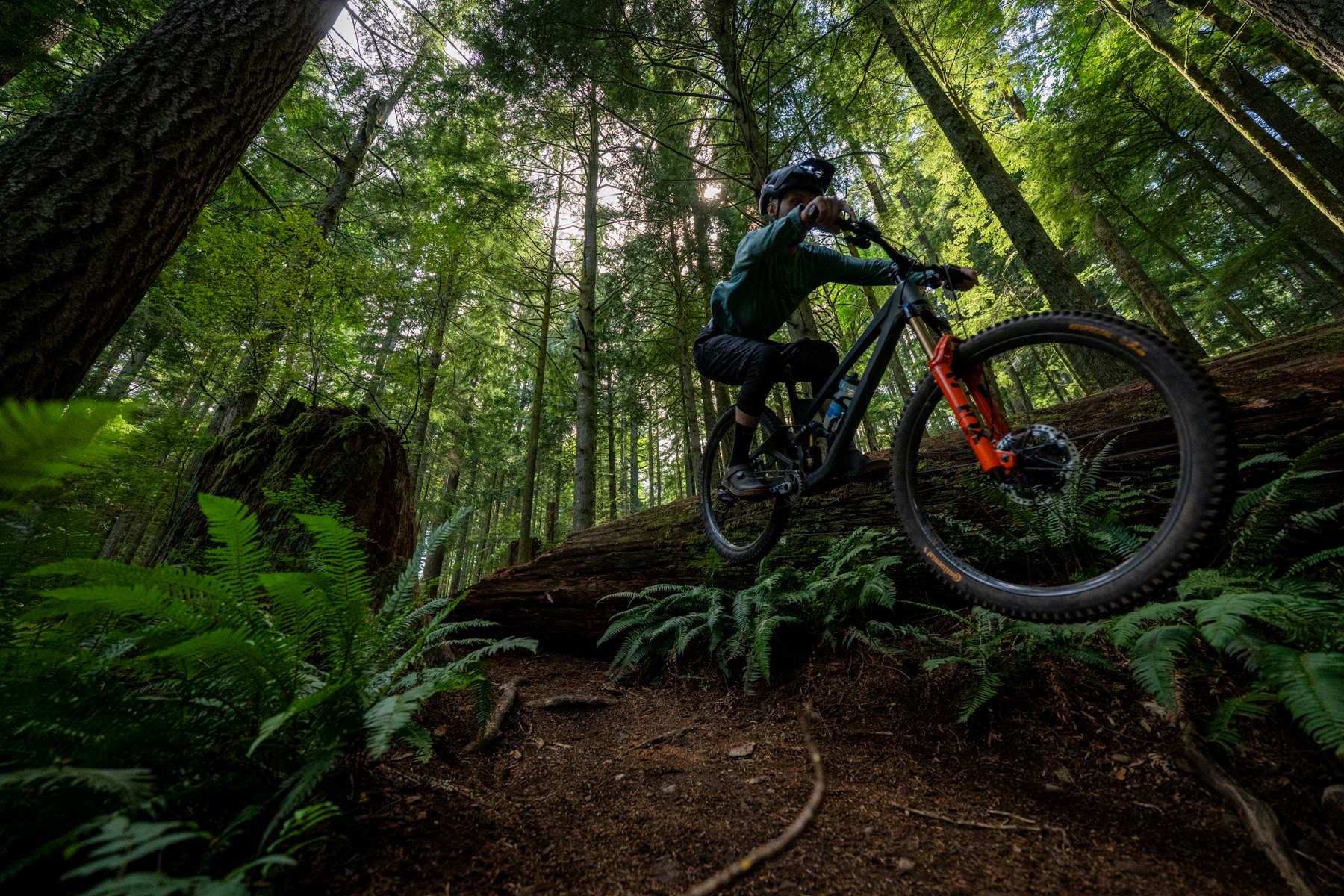
My main reason for preferring the HS version is simply that I like the less padded upper and the more secure-feeling fit that it delivers. It’s not a huge difference, but there’s a little less give in the upper of the GE9HS, which translates to a slightly more solid-feeling connection to the bike and a little more control. The GE9HS also absorbs a bit less water in really wet conditions, and dries out faster afterward.
The bump up in midsole stiffness is also noticeable, but subtle. Both the standard GE9 and the HS version strike a nice balance for my taste, and I don’t feel strongly about preferring one over the other on that front. They’re both appreciably stiffer than the Shimano AM9 that they replaced or the Crank Brothers Mallet DH, and a little less stiff than the Specialized 2FO DH or Shimano ME7, for example.
Big picture, the GE9HS is just a well-executed gravity-oriented shoe. Its sole is stiff enough to pedal well and feel supportive on the way back down without being punishing to ride or hard to walk in; they breathe fine, if not exceptionally well; they offer reasonable protection while still being relatively low-profile / not super bulky; and they’re holding up great for me. The cleat slot is far enough back to make me happy — something that’s an issue on a lot of more XC-oriented shoes — and the overall design and feature set is well sorted.

Off the Bike
Surprise: the GE9 and GE9HS are pretty similar here, too. While there are some softer-soled options that bend with your foot more freely, the midsole of both GE9 variants softens up a good bit in the toe area, which helps on steeper scrambles in particular. Their shared outsole is relatively grippy for a clip shoe — and much more so than the Shimano AM9 of old — while still being harder wearing than I might have guessed, given its pretty good grip (again, by clip shoe standards) on wet rocks and the like.
If anything, I like walking in the GE9HS slightly better because I get a little less heel movement in them between the slimmer fit and less padded upper, and the difference in midsole stiffness isn’t large enough to matter much. And they use the exact same outsole. The neoprene ankle gaiter, while not 100% reliable, also does a generally good job of keeping dirt and pebbles out of the shoe.
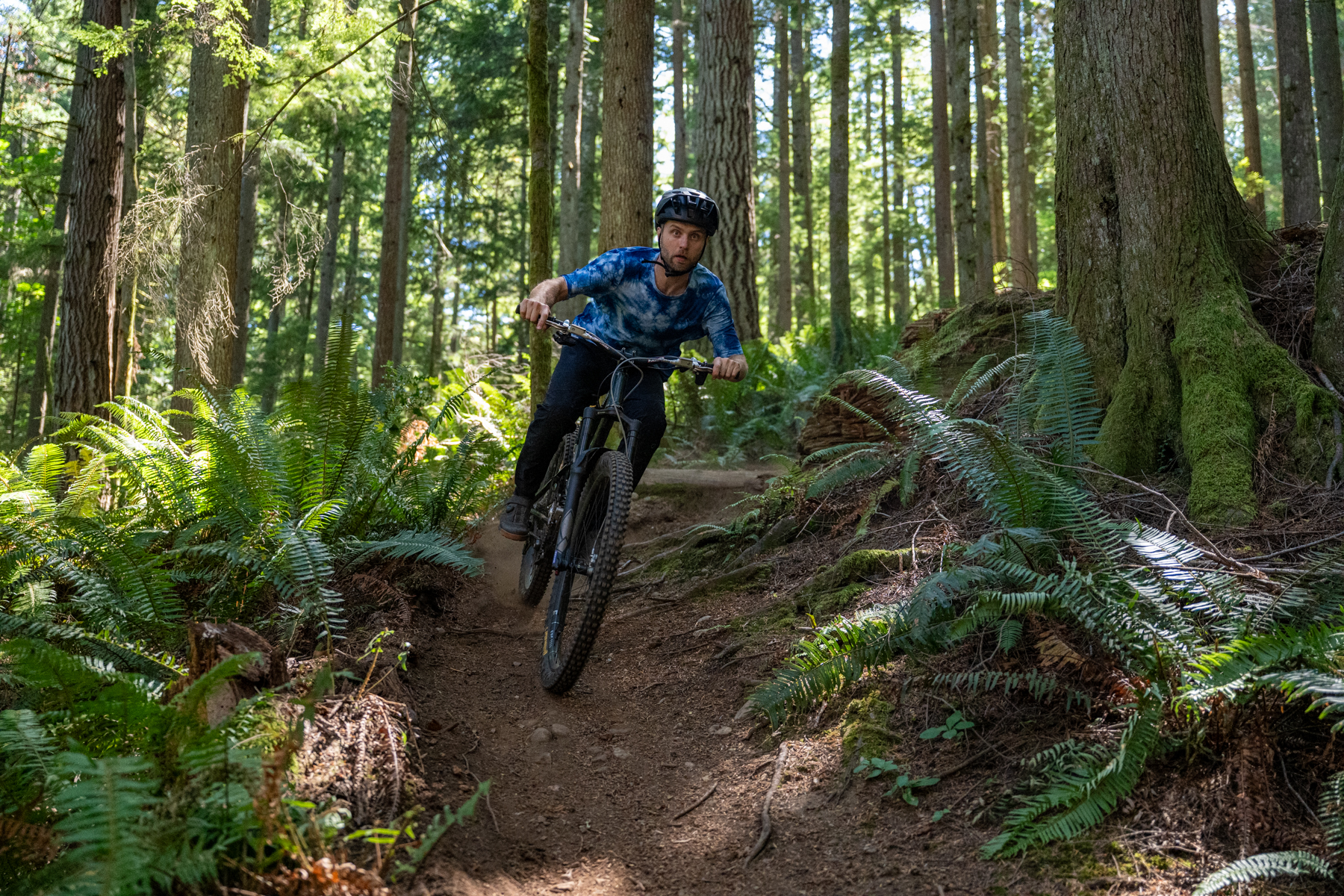
Bottom Line
The Shimano GE9 was already one of my favorite gravity-oriented clip shoes (the Specialized 2FO DH being its prime competitor for that slot), and the GE9HS is, for my taste, a lightly improved version. The two are more similar than they are different, but the HS version fits a little more snugly, features a slightly stiffer sole, and shaves off a little bit of weight (~30 grams per shoe, for my size 44 samples). None of those differences is huge, and I don’t think many folks are going to feel wildly different about one version than the other. Rather, I’d think of them as two different twists on the same core concept: the GE9 is a well-rounded gravity clip shoe, and the GE9HS is its sibling that’s been hitting the gym more. If you want the slightly roomier, more padded version, go GE9. For a more snug fit and more taut-feeling connection to the bike, the GE9HS is the move.

I used the GE900 for a few months and it was always too wide for my narrow feet. And softer than I like in the midsole. The GE900HS is not night and day different, but it improves those two areas for my personal tastes enough to satisfy me. I didn’t gel super well with the GE900 but the GE900HS is working for me. Enough that I don’t think about them nearly as much. I just ride. I will say I do appreciate the dual direction BOA on the GE900HS because sometimes I like to loosen the fit by just one click rather than popping them open and starting to cinch them down again from scratch. Also, I find the ankle strap and thinner tongue of the GE900HS feel more secure locking down my instep without a sensation of pinching.